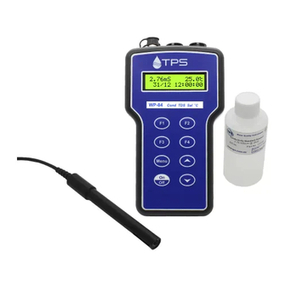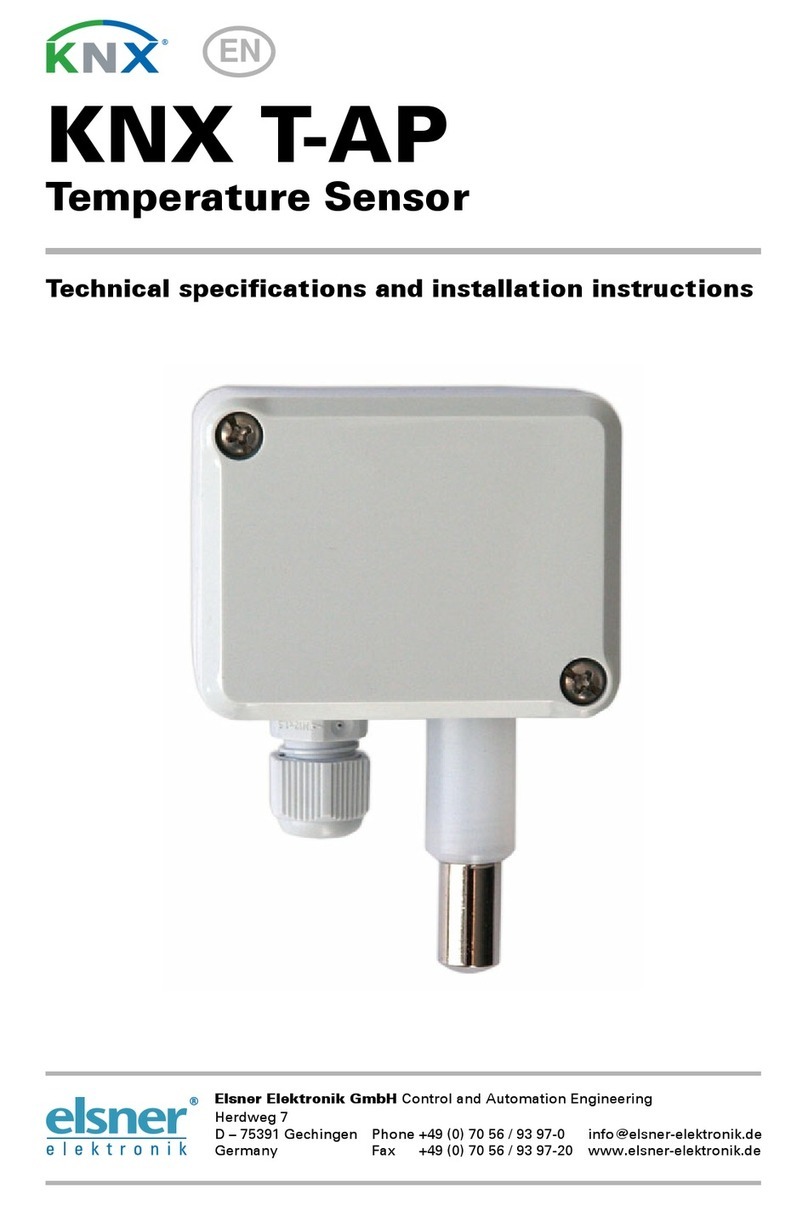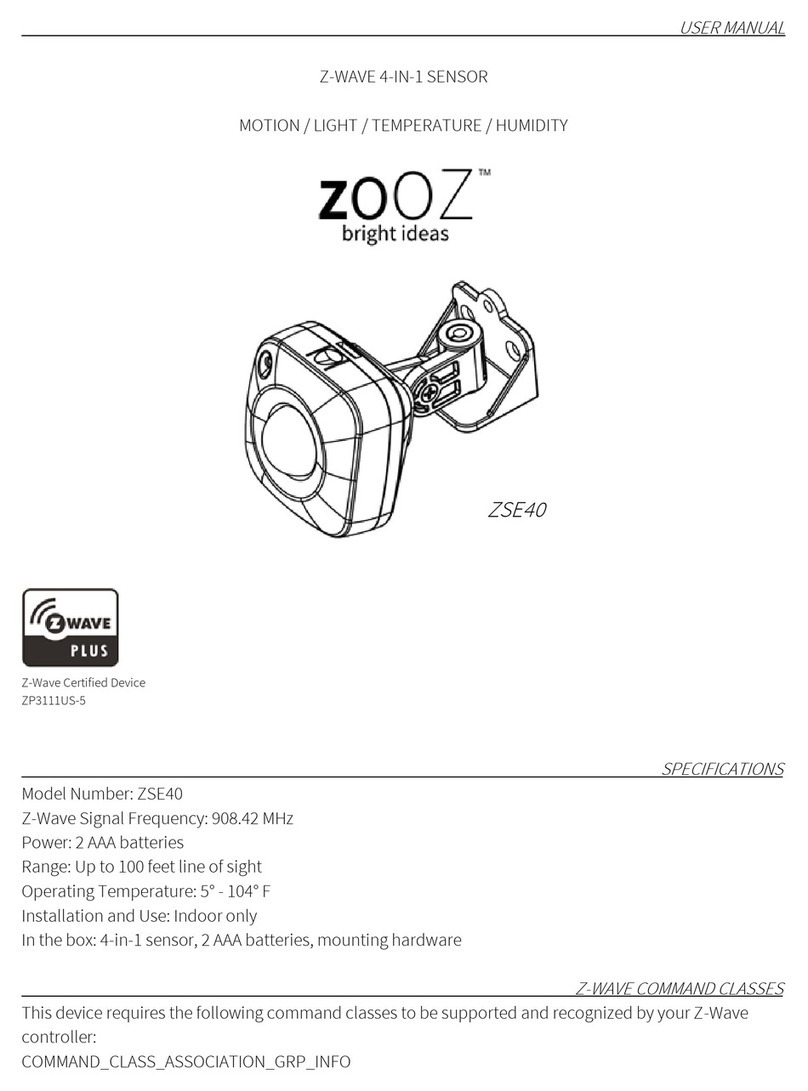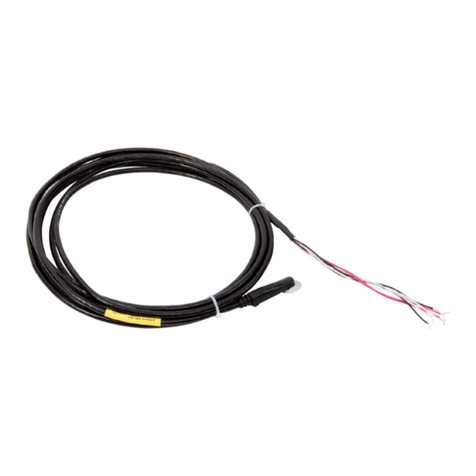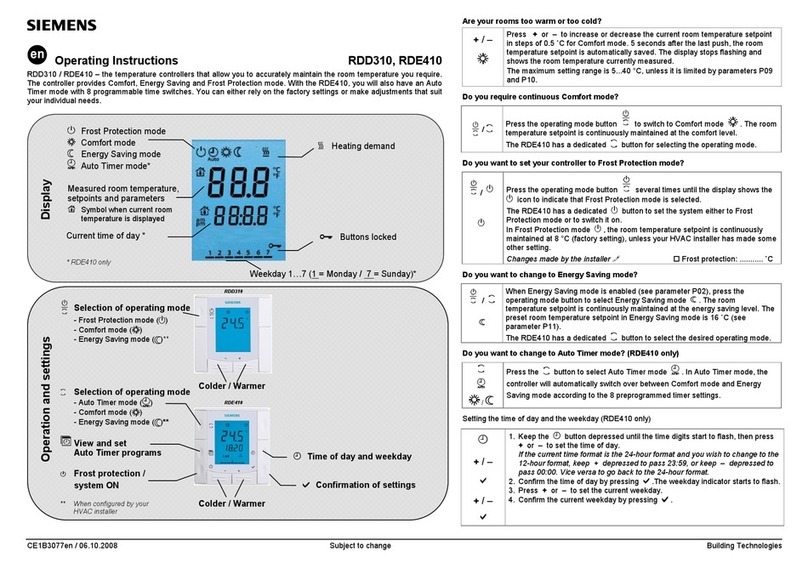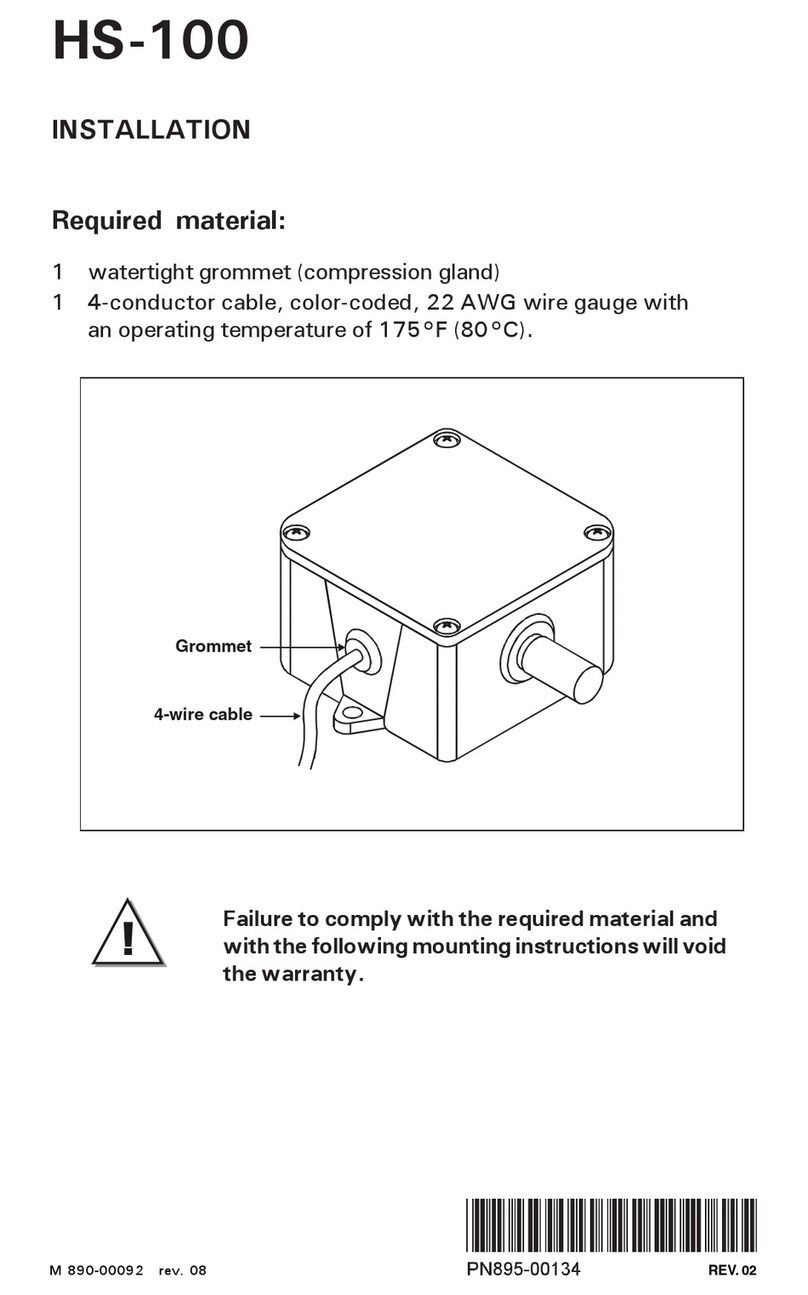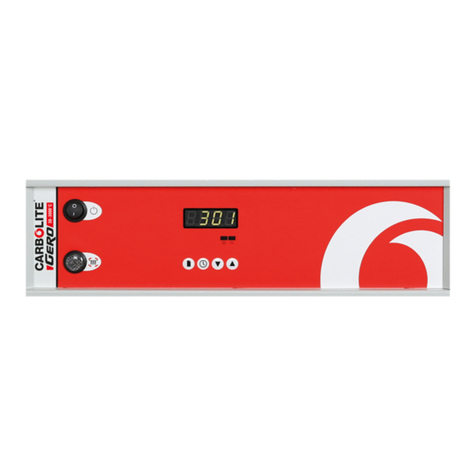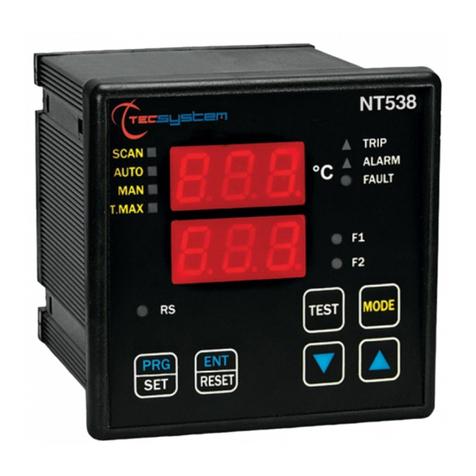SENSIRION STS32-DIS User manual

www.sensirion.com / D1 Version 3 –December 2022 1/24
STS32/33-DIS
3th Generation, High-Reliability, Certified
Digital Temperature Sensor
Features
•Accuracy ±0.4 °C
•VDD = 2.15 V … 5.5 V
•Low drift, <0.01 °C per year
•Sensor-specific calibration certificate acc. to
ISO 17025:2017, 3-point temp. calibration
•Operating range: −40…125 °C
•True NIST-traceability, unique serial number
•JEDEC JESD47 qualification
•I2C FM, CRC checksum, multip. I2C addr.
•Tiny 8-pin DFN package with ALERT pin
General Description
The STS32/33-DIS are Sensirion’s new low-drift digital calibrated and ISO17025 certified
temperature sensors. Both rely on the industry proven CMOSens® technology, enabling
increased computational power, reliability and improved accuracy specifications compared to
its predecessors. Itsfunctionality includes enhanced signal processing, two distinctive and user
selectable I2C addresses and communication speeds of up to 1 MHz. The DFN package has
a footprint of 2.5 x 2.5 mm2while keeping a height of 0.9 mm. Every STS32 or STS33 is
identified by its unique serial number and is supplied with an ISO17025-accredited calibration
certificate. The calibration certificate comprises three temperatures, −30 °C, 5 °C, and 70 °C.
In terms of communication, electrical specifications, and footprint, the SHT33-DIS is fully identical
with the STS3x-DIS.
Device Overview
Functional Block Diagram
Products
Details
STS32-DIS
ISO17025 3-point calibration certificate
accuracy profile 1
STS33-DIS
ISO17025 3-point calibration certificate
accuracy profile 2
Full product list on page 22
SCAN ME to give feedback and help us to
improve this document. —Thank you!

www.sensirion.com / D1 Version 3 –December 2022 2/24
Contents
Features........................................................................................................................................................................1
General Description...................................................................................................................................................1
Device Overview.........................................................................................................................................................1
Functional Block Diagram........................................................................................................................................1
Contents........................................................................................................................................................................2
1 Sensor Performance..............................................................................................................................................4
1.1 Temperature.....................................................................................................................................................4
1.2 ISO17025 certification with 3-point calibration data.............................................................................5
2 Electrical Specifications........................................................................................................................................6
2.1 Electrical Characteristics..............................................................................................................................6
2.2 Timings...............................................................................................................................................................7
2.3 Absolute Maximum Ratings.........................................................................................................................7
3 Pin Assignment........................................................................................................................................................8
3.1 Power Pins (VDD, VSS) ...............................................................................................................................8
3.2 Serial Clock and Serial Data (SCL, SDA)...............................................................................................8
3.3 Die Pad (center pad)......................................................................................................................................9
3.4 ADDR Pin..........................................................................................................................................................9
3.5 ALERT Pin........................................................................................................................................................9
3.6 nRESET Pin .....................................................................................................................................................9
4 Operation and Communication.........................................................................................................................10
4.1 Power-Up and Communication Start......................................................................................................10
4.2 Starting a Measurement.............................................................................................................................10
4.3 Measurement Commands for Single Shot Data Acquisition...........................................................10
4.4 Readout of Measurement Results for Single Shot Method.............................................................11
4.5 Measurement Commands for Periodic Data Acquisition Mode......................................................11
4.6 Readout of Measurement Results for Periodic Mode........................................................................12
4.7 Break command/ Stop Periodic Data Acquisition Mode...................................................................13
4.8 Reset.................................................................................................................................................................13
4.9 Heater...............................................................................................................................................................14
4.10 Status Register............................................................................................................................................15
4.11 Serial Number..............................................................................................................................................15
4.12 Checksum Calculation..............................................................................................................................17
4.13 Conversion Signal Output........................................................................................................................17
4.14 Communication Timing.............................................................................................................................18
5 Packaging................................................................................................................................................................19
5.1 Traceabilty.......................................................................................................................................................19
5.2 Package Outline............................................................................................................................................19
5.3 Land Pattern...................................................................................................................................................20
6 Shipping Package.................................................................................................................................................21

www.sensirion.com / D1 Version 3 –December 2022 3/24
7 Quality and Material Contents...........................................................................................................................21
8 Product Nomenclature.........................................................................................................................................22
9 Ordering Information............................................................................................................................................22
10 Bibliography..........................................................................................................................................................22
11 Revision History..................................................................................................................................................23

www.sensirion.com / D1 Version 3 –December 2022 4/24
1 Sensor Performance
Every STS33/32 is individually tested and calibrated and is identifiable by its unique serial number
(see section 4.11 for details on the serial number). For the calibration, Sensirion uses transfer
standards, which are subject to a scheduled calibration procedure. The calibration of the reference,
used for the calibration of the transfer standards, is NIST traceable through an ISO/IEC 17025
accredited laboratory.
1.1 Temperature
Parameter
Conditions
Value
Units
STS32 Accuracy
max. 0°C to 65°C
0.4
°C
max.
See Figure 1
-
STS33 T Accuracy
max. −30°C to 70°C
0.48
°C
max.
See Figure 1
-
Repeatability1
high
0.04
°C
medium
0.08
°C
low
0.15
°C
Resolution
-
0.01
°C
Specified range
-
–40 to +125
°C
Response time2
63%
>2
s
Long-term drift
typ.
<0.01
°C/y
Table 1. General temperature sensor specifications.
Figure 1. Maximal Temperature accuracy of the STS32 (left) and STS33 (right), respectively. The green lines
represent the calibration points for ISO-17025 certification.
1
The stated repeatability is 3 times the standard deviation (3σ) of multiple consecutive measurements at the stated repeatability and at constant ambient conditions.
It is a measure for the noise on the physical sensor output.
2
Temperature response time depends on heat conductivity of sensor substrate and design-in of sensor in application. [2]
±0.0
±0.5
±1.0
±1.5
-40 -20 0 20 40 60 80 100 120
Temperature (°C)
STS32
maximal tolerance
DT (°C)
±0.0
±0.5
±1.0
±1.5
-40 -20 0 20 40 60 80 100 120
Temperature (°C)
STS33
maximal tolerance
DT (°C)

www.sensirion.com / D1 Version 3 –December 2022 5/24
1.2 ISO17025 certification with 3-point calibration data
All STS32 and STS33 can be uniquely identified by their serial number (read out command see
paragraph 4.11). For each sensor an individual 3-point calibration is performed, accredited to
ISO/IEC 17025:2017. The accreditation is performed and granted by the Swiss Accreditation
Service (SAS), a public institution of the Swiss Government. The accreditation is documented on
the SAS website under the name SCS 0158 and can be downloaded from this link
3
. The three
calibration temperatures are T = −30 °C, T = 5 °C, and T = 70 °C. Measurement uncertainties and
decision rules according to the SAS are given in Table 2.
Metrological traceability of the calibration is in accordance to ch. 6.5 of ISO/IEC 17025:2017,
encompassing but not limited to NIST traceability or traceability to other national metrology
institutes, according to the CIPM Mutual Recognition Arrangement (CIPM MRA).
Reel-wise calibration certificates and data for each STS32/33 can be downloaded through a web-
client and through an API from libellus.sensirion.com, which allows for efficient processing by
automated systems. For detailed documentation, kindly refer to the Libellus documentation.
Temperature
Expanded measurement uncertainty (k=2)*
Decision rule
−30 °C
0.40 °C
Shared risk (JCGM 106:2010, 8.2)
5 °C
0.20 °C
Shared risk (JCGM 106:2010, 8.2)
70 °C
0.20 °C
Shared risk (JCGM 106:2010, 8.2)
Table 2. Measurement uncertainty and decision rule for the accredited calibration according to Swiss
Accreditation Service (SAS). *Measurement uncertainties represent a confidence level of 95% using a
coverage factor of k = 2.
3
https://www.sas.admin.ch/sas/en/home/akkreditiertestellen/akkrstellensuchesas.exturl.html/aHR0cHM6Ly9zYXNkYi5jbGllbnRzLmxpaXAuY2gvc2VhcmNoLm/h0bWw=.html?csrfmiddlewa
retoken=2Ie2f1aOTUge9YQ3nuaL0ILEYS980ZMdH60doLdY8Nh1sHC3wpw3YvLLVBezmDRn&lang=en&search_term=0158&accreditation_type=2&submit=Start+search

www.sensirion.com / D1 Version 3 –December 2022 6/24
2 Electrical Specifications
2.1 Electrical Characteristics
Parameter
Symbol
Condition
Min.
Typ.
Max.
Units
Comments
Supply
voltage
VDD
2.15
3.3
5.5
V
Power-
up/down level
VPOR
1.8
2.1
2.15
V
Slew rate
change of the
supply voltage
VDD,slew
-
-
20
V/ms
Voltage changes
on the VDD line
between VDD,min
and VDD,max should
be slower than the
maximum slew
rate; faster slew
rates may lead to
reset;
Supply current
IDD
idle state
(single shot
mode)
T = 25 °C
-
0.2
2.0
µA
Current when
sensor is not
performing a
measurement
during single shot
mode
idle state
(single shot
mode)
T = 125 °C
-
-
6.0
idle state
(periodic data
acquisition
mode)
-
45
-
µA
Current when
sensor is not
performing a
measurement
during periodic data
acquisition mode
Measuring
-
600
1500
µA
Current
consumption while
sensor is
measuring
Average
-
1.7
-
µA
Current
consumption
(operation with one
measurement per
second at lowest
repeatability, single
shot mode)
Alert Output
driving
strength
IOH
1.5x
VDD
mA
See also section
3.5
Heater power
PHeater
Heater running
3.6
-
33
mW
Depending on the
supply voltage
Table 3. Electrical specifications, typical values are valid for T = 25 °C, min. & max. values for
T = −40 °C …125 °C.

www.sensirion.com / D1 Version 3 –December 2022 7/24
2.2 Timings
Parameter
Symbol
Conditions
Min.
Typ.
Max.
Units
Comments
Power-up time
tPU
After hard reset,
VDD ≥ VPOR
-
0.5
1.5
ms
Time between VDD
reaching VPOR and sensor
entering idle state
Soft reset time
tSR
After soft reset
-
-
1
ms
Time between ACK of soft
reset command and
sensor entering idle state.
Measurement
duration
tMEAS,l
Low repeatability
-
2.5
4.5
ms
The three repeatability
modes differ with respect
to measurement duration,
noise level and energy
consumption
tMEAS,m
Med. repeatability
-
4.5
6.5
ms
tMEAS,h
High repeatability
-
12.5
15.5
ms
Duration of reset
pulse
tRESETN
1
-
-
µs
See section 4.8
Table 4. System timing specifications (valid from −40 °C to 125 °C and VDD,min … VDD, max ).
2.3 Absolute Maximum Ratings
Stress levels beyond those listed in Table 5 may cause permanent damage or affect the reliability
of the device. These are stress ratings only and functional operation of the device at these
conditions is not guaranteed. Ratings are only tested each at a time.
Parameter
Rating
Supply voltage VDD
−0.3 V to 6 V
Max. voltage on any pin
VSS −0.3 V … VDD +0.3 V
Input current on any pin
±100 mA
Operating temperature range
−40 °C … 125 °C
Storage temperature range4
−40 °C …150 °C
ESD HBM5
4 kV
ESD CDM6
750 V
Table 5. Absolute maximum ratings. Values may be only applied for short time periods.
4
The recommended storage temperature range is 10-50 °C. Please consult the document “SHTxx Handling Instructions” [4] for more information.
5
According to ANSI/ESDA/JEDEC JS-001-2014; AEC-Q100-002.
6
According to ANSI/ESD S5.3.1-2009; AEC-Q100-011.

www.sensirion.com / D1 Version 3 –December 2022 8/24
3 Pin Assignment
The STS32/33-DIS come in a tiny 8-pin DFN package –see Table 6.
Pin
Name
Comments
1
SDA
Serial data; input / output
2
ADDR
Address pin; input; connect to either logic high or low, do not leave
floating
3
ALERT
Indicates alarm condition; output; must be left floating if unused
4
SCL
Serial clock; input / output
5
VDD
Supply voltage; input
6
nRESET
Reset pin active low; input; if not used it is recommended to be left
floating; can be connected to VDD with a series resistor of R ≥2 kΩ.
7
R
No electrical function; to be connected to VSS
8
VSS
Ground
Table 6. STS32/33-DIS pin assignment (transparent top view). Dashed lines are only visible if viewed from
below. The die pad is internally connected to VSS.
3.1 Power Pins (VDD, VSS)
The electrical specifications of the STS32/33-DIS are shown Table 3. The power supply pins must
be decoupled with a 100 nF capacitor that shall be placed as close to the sensor as possible –see
Figure 2 for a typical application circuit.
3.2 Serial Clock and Serial Data (SCL, SDA)
SCL is used to synchronize the communication between microcontroller and the sensor. The clock
frequency can be freely chosen between 0 to 1000 kHz. Commands with clock stretching according
to I2C Standard
7
are supported. The SDA pin is used to transfer data to and from the sensor.
Communication with frequencies up to 400 kHz must meet the I2C Fast Mode7standard.
Communication frequencies up to 1 MHz are supported following the specifications given in Table
20. Both SCL and SDA lines are open-drain I/Os with diodes to VDD and VSS. They should be
connected to external pull-up resistors (please refer to Figure 2). A device on the I2C bus must
only drive a line to ground. The external pull-up resistors (e.g. Rp = 10 kΩ) are required to pull the
signal high. For dimensioning resistor sizes please takebus capacity andcommunicationfrequency
into account (see for example Section 7.1 of NXPs I2C Manual for more details [1]). It should be
noted that pull-up resistors may be included in I/O circuits of microcontrollers. It is recommended
to wire the sensor according to the application circuit as shown in Figure 2.
1
2
3
45
8
7
6

www.sensirion.com / D1 Version 3 –December 2022 9/24
Figure 2. Typical application circuit. Please note that the positioning of the pins does not reflect the position
on the real sensor. This is shown in Table 6.
3.3 Die Pad (center pad)
The die pad or center pad is visible from below and located in the center of the package. It is
electrically connected to VSS. Hence electrical considerations do not impose constraints on the
wiring of the die pad. However, due to mechanical reasons it is recommended to solder the center
pad to the PCB. For more information on design-in, please refer to the document “SHTxx_STSxx
Design Guide” [2].
3.4 ADDR Pin
Through the appropriate wiring of the ADDR pin the I2C address can be selected (see Table 7 for
the respective addresses). The ADDR pin can either be connected to logic high or logic low. The
address of the sensor can be changed dynamically during operation by switching the level on the
ADDR pin. The only constraint is that the level has to stay constant starting from the I2C start
condition until the communication is finished. This allows to connect more than two STS32/33-DIS
onto the same bus. The dynamical switching requires individual ADDR lines to the sensors. Please
note that the I2C address is represented through the 7 MSBs of the I2C read or write header. The
LSB switches between read or write header. The wiring for the default address is shown Table 7
and Figure 2. The ADDR pin must not be left floating. Please note that only the 7 MSBs of the I2C
Read/Write header constitute the I2C Address.
STS32/33-DIS
I2C Address in Hex. representation
Condition
I2C address A
0x4A (default)
ADDR (pin 2) connected to logic low
I2C address B
0x4B
ADDR (pin 2) connected to logic high
Table 7. I2C Device addresses
3.5 ALERT Pin
The alert pin may be used to connect to the interrupt pin of a microcontroller. The output of the pin
depends on the value of the temperature reading relative to programmable limits. Its function is
explained in a separate application note. If not used, this pin must be left floating. The pin switches
high when alert conditions are met. The maximum driving loads are listed in Table 3. Be aware
that self-heating might occur, depending on the amount of current that flows. Self-heating can be
prevented if the Alert Pin is only used to switch a transistor.
3.6 nRESET Pin
The nReset pin may be used to generate a reset of the sensor. A minimum pulse duration of 1 µs
is required to reliably trigger a reset of the sensor. Its function is explained in more detail in section
4. If not used it is recommended to leave the pin floating or to connect it to VDD with a series
VDD
RR
PP
100nF
ADDR(2)
ALERT(3)
die
pad R(7)
SDA(1)
SCL(4)
VDD(5)
VSS(8)
nRESET(6)

www.sensirion.com / D1 Version 3 –December 2022 10/24
resistor of R≥2 kΩ. However, the nRESET pin is internally connectedto VDD with a pull up resistor
of R = 50 kΩ (typ.).
4 Operation and Communication
The STS32/33-DIS supports I2C fast mode (and frequencies up to 1000 kHz). Clock stretching can
be enabled and disabled through the appropriate user command. For detailed information on the
I2C protocol, refer to NXP I2C-bus specification [1]. After sending a command to the sensor a
minimal waiting time of 1 ms is needed before another command can be received by the sensor.
All STS32/33-DIS commands and data are mapped to a 16-bit address space. Additionally, data
and commands are protected with a CRC checksum. This increases communication reliability. The
16 bits commands to the sensor already include a 3 bit CRC checksum. Data sent from and
received by the sensor is always succeeded by an 8 bit CRC. In write direction it is mandatory to
transmit the checksum, since the STS32/33-DIS only accepts data if it is followed by the correct
checksum. In read direction it is left to the master to read and process the checksum.
4.1 Power-Up and Communication Start
The sensor starts powering-up after reaching the power-up threshold voltage VPOR specified in
Table 3. After reaching this threshold voltage the sensor needs the time tPU to enter idle state. Once
the idle state is entered it is ready to receive commands from the master (microcontroller). Each
transmission sequence begins with a START condition (S) and ends with a STOP condition (P) as
described in the I2C-bus specification. Whenever the sensor is powered up, but not performing a
measurement or communicating, it automatically enters idle state for energy saving. This idle state
cannot be controlled by the user.
4.2 Starting a Measurement
A measurement communication sequence consists of a START condition, the I2C write header (7-
bit I2C device address plus 0 as the write bit) and a 16-bit measurement command. The proper
reception of each byte is indicated by the sensor. It pulls the SDA pin low (ACK bit) after the falling
edge of the 8th SCL clock to indicate the reception. A complete measurement cycle is depicted in
Table 8. With the acknowledgement of the measurement command, the STS32/33-DIS starts
measuring the temperature.
4.3 Measurement Commands for Single Shot Data Acquisition
In this mode one issued measurement command triggers the acquisition of a 16 bit temperature
value. During transmission that value is always followed by a CRC checksum, see section 4.4. In
single shot mode different measurement commands can be selected. The 16 bit commands are
shown in Table 8. They differ with respect to repeatability (low, medium and high) and clock
stretching (enabled or disabled). The repeatability setting influences the measurement duration
and thus the overall energy consumption of the sensor. This is explained in section 2.2.

www.sensirion.com / D1 Version 3 –December 2022 11/24
Condition
Hex. code
Repeatability
Clock stretching
MSB
LSB
High
enabled
0x2C
06
Medium
0D
Low
10
High
disabled
0x24
00
Medium
0B
Low
16
e.g. 0x2C06: high repeatability measurement with clock stretching enabled
Table 8. Measurement commands in single shot mode. The first “SCL free” block indicates a minimal waiting
time of 1 ms (clear blocks are controlled by the microcontroller, grey blocks by the sensor).
4.4 Readout of Measurement Results for Single Shot Method
After the sensor has completed the measurement, the master can read the measurement result by
sending a START condition followed by an I2C read header. The sensor will acknowledge the
reception of the read header and send two bytes of data (temperature) followed by a one-byte CRC
checksum. Each byte must be acknowledged by the microcontroller with an ACK condition for the
sensor to continue sending data. If the sensor does not receive an ACK from the master after any
byte of data, it will not continue sending data. After having received the checksum for the
temperature value a NACK and stop condition should be sent (see Table 8). The I2C master can
abort the read transfer with a NACK condition after any data byte if it is not interested in the CRC.
No Clock Stretching
When a command without clock stretching has been issued, the sensor responds to a read header
with a not acknowledge (NACK), if no data is present.
Clock Stretching
When a command with clock stretching has been issued, the sensor responds to a read header
with an ACK and subsequently pulls down the SCL line. The SCL line is pulled down until the
measurement is complete. As soon as the measurement is complete, the sensor releases the SCL
line and sends the measurement results.
4.5 Measurement Commands for Periodic Data Acquisition Mode
In this mode one issued measurement command yields a stream of 16 bit temperature values. In
periodic mode different measurement commands can be selected. The corresponding 16 bit
commands are shown in Table 9. They differ with respect to repeatability (low, medium and high)
and data acquisition frequency (0.5, 1, 2, 4 & 10 measurements per second, mps). Clock stretching
cannot be selected in this mode.
SCL free
SCL free
I2C Address
Temperature MSB
16-bit command
I2C write header
I2C read header
I2C Address
I2C Address
I2C read header
measurement
completed
measurement
ongoing
measurement
ongoing
measurement
ongoing
SCL pulled low
Temperature LSB
16-bit temperature value Checksum
S
S
W P
CRC
P
R
R
clock stretching
disabled
clock stretching
enabled
ACK
ACK
ACK
Command LSBCommand MSB
S
NACK
ACK
ACK
ACK NACK
P
ACK

www.sensirion.com / D1 Version 3 –December 2022 12/24
The data acquisition frequency and the repeatability setting influence the measurement duration
and the current consumption of the sensor. This is explained in 2.2 of this datasheet. If a
measurement command is issued, while the sensor is busy with a measurement (measurement
durations see Table 4), it is recommended to issue a break command first (see section 4.7). Upon
reception of the break command the sensor will abort the ongoing measurement and enter the
single shot mode.
Condition
Hex. code
Repeatability
mps
MSB
LSB
High
0.5
0x20
32
Medium
24
Low
2F
High
1
0x21
30
Medium
26
Low
2D
High
2
0x22
36
Medium
20
Low
2B
High
4
0x23
34
Medium
22
Low
29
High
10
0x27
37
Medium
21
Low
2A
e.g. 0x2130: one high repeatability measurement per second (mps)
Table 9. Measurement commands for periodic data acquisition mode (clear blocks are controlled by the
microcontroller, grey blocks by the sensor). N.B.: At the highest mps setting self-heating of the sensor might
occur.
4.6 Readout of Measurement Results for Periodic Mode
Transmission of the measurement data can be initiated through the fetch data command shown in
Table 10. If no measurement data is present the I2C read header is responded with a NACK (Bit
9 in Table 9. Measurement commands for periodic data acquisition mode (clear blocks are
controlled by the microcontroller, grey blocks by the sensor). N.B.: At the highest mps setting self-
heating of the sensor might occur.) and the communication stops. After the read-out command
fetch data has been issued, the data memory is cleared, i.e. no measurement data is present.

www.sensirion.com / D1 Version 3 –December 2022 13/24
Command
Hex code
Fetch Data
0x E0 00
Table 10.Fetch Data command (clear blocks are controlled by the microcontroller, grey blocks by the sensor)
4.7 Break command/ Stop Periodic Data Acquisition Mode
The periodic data acquisition mode can be stopped using the break command shown in Table 11.
It is recommended to stop the periodic data acquisition prior to sending another command (except
Fetch Data command) using the break command. Upon reception of the break command the
sensor will abort the ongoing measurement and enter the single shot mode. This takes 1 ms.
Command
Hex Code
Break
0x3093
Table 11.Break command (clear blocks are controlled by the microcontroller, grey blocks by the sensor).
4.8 Reset
A system reset of the STS32/33-DIS can be generated externally by issuing a command (soft reset)
or by sending a pulse to the dedicated reset pin (nReset pin). Additionally, a system reset is
generated internally during power-up. During the reset procedure the sensor will not process
commands. In order to achieve a full reset of the sensor without removing the power supply, it is
recommended to use the nRESET pin of the STS32/33-DIS.
Interface Reset
If communication with thedevice is lost, the following signal sequence will reset the serial interface:
While leaving SDA high, toggle SCL nine or more times. This must be followed by a Transmission
Start sequence preceding the next command. This sequence resets the interface only. The status
register preserves its content.
Soft Reset / Re-Initialization
The STS32/33-DIS provides a soft reset mechanism that forces the system into a well-defined state
without removing the power supply. When the system is in idle state the soft reset command can
be sent to the STS32/33-DIS. This triggers the sensor to reset its system controller and reloads
calibration data from the memory. In order to start the soft reset procedure the command as shown
in Table 12 should be sent. It is worth noting that the sensor reloads calibration data prior to every
measurement by default.
I2C Address
Temperature MSB
16-bit command
I2C write header
I2C read header
I2C Address
Temperature LSB
16-bit temperature value Checksum
S W P
CRC
R
ACK
ACK
ACK
Command LSBCommand MSB
S
ACK
ACK
ACK
P
NACK

www.sensirion.com / D1 Version 3 –December 2022 14/24
Command
Hex Code
Soft Reset
0x30A2
Table 12. Soft reset command (clear blocks are controlled by the microcontroller, grey blocks by the sensor)
Reset through General Call
Additionally, a reset of the sensor can also be generated using the “general call” mode according
to I2C-bus specification. This generates a reset which is functionally identical to using the nReset
pin. It is importantto understand that a reset generated inthis way is notdevice specific. All devices
on the same I2C bus that support the general call mode will perform a reset. Additionally, this
command only works when the sensor can process I2C commands. The appropriate command
consists of two bytes and is shown in Table 13.
Command
Code
Address byte
0x00
Second byte
0x06
Reset command using the
general call address
0x0006
Table 13.Reset through the general call address (clear blocks are controlled by the microcontroller, grey
blocks by the sensor).
Reset through the nReset Pin
Pulling the nReset pin low (see Table 6) generates a reset similar to a hard reset. The nReset pin
is internally connected to VDD through a pull-up resistor and hence active low. The nReset pin has
to be pulled low for a minimum of 1 µs to generate a reset of the sensor.
Hard Reset
A hard reset is achieved by switching the supply voltage to the VDD Pin off and then on again. In
order to prevent powering the sensor over the ESD diodes, the voltage to pins 1 (SDA), 4 (SCL)
and 2 (ADDR) also needs to be removed.
4.9 Heater
The STS32/33 is equipped with an internal heater, which is meant for plausibility checking only.
The temperature increase achieved by the heater depends on various parameters and lies in the
range of a few degrees centigrade. It can be switched on and off by command, see table below.
The status is listed in the status register. After a reset the heater is disabled (default condition).

www.sensirion.com / D1 Version 3 –December 2022 15/24
Command
Hex Code
MSB
LSB
Heater Enable
0x30
6D
Heater Disabled
66
Table 14.Heater command (clear blocks are controlled by the microcontroller, grey blocks by the sensor)
4.10 Status Register
The status register contains information on the operational status of the heater, the alert mode and
on the execution status of the last command and the last write sequence. The command to read
out the status register is shown in Table 15 whereas a description of the content can be found in
Table 18.
Command
Hex code
Read Out of status register
0xF32D
Table 15.Command to read out the status register (clear blocks are controlled by the microcontroller, grey
blocks by the sensor)
Clear Status Register
All flags (Bit 15, 10, 4) in the status register can be cleared (set to zero) by sending the command
shown in Table 16.Command to clear the status register (clear blocks are controlled by the
microcontroller, grey blocks by the sensor).
Command
Hex Code
Clear status register
0x 30 41
Table 16.Command to clear the status register (clear blocks are controlled by the microcontroller, grey
blocks by the sensor)
4.11 Serial Number
The Serial number allows for an unambiguous identification of each individual device, it is stored
in the one-time programmable (OTP) memory of the chip. Table 17 shows the command structure
to read the serial number. After issuing the measurement command and sending the ACK bit the
sensor needs the time tIDLE = 1 ms to respond to the I2C read header with an ACK bit. Hence it is
recommended to wait tIDLE = 1 ms before issuing the read header. The Get Serial Number
command returns two words, every word is followed by a CRC Checksum. Together the 2 words
(SNB_3 to SNB_0 in Table 17, SNB_0 is the LSB,whereas SNB_3 is the MSB) constitute a unique
serial number with a length of 32 bit. This serial number can be used to individually identify each
sensor.

www.sensirion.com / D1 Version 3 –December 2022 16/24
Command
Hex Code
Get Serial Number
0x 37 80
0x 36 82
Table 17. Command to read out the Serial Number (clear blocks are controlled by the microcontroller, grey
blocks by the sensor)
Bit
Field description
Default value
15
Alert pending status
'0': no pending alerts
'1': at least one pending alert
‘1’
14
Reserved
‘0’
13
Heater status
‘0’ : Heater OFF
‘1’ : Heater ON
‘0’
12:11
Reserved
‘00’
10
T tracking alert
‘0’ : no alert
‘1’ . alert
‘0’
9:5
Reserved
‘xxxxx’
4
System reset detected
'0': no reset detected since last ‘clear status register’
command
'1': reset detected (hard reset, soft reset command or
supply fail)
‘1’
3:2
Reserved
‘00’
1
Command status
'0': last command executed successfully
'1': last command not processed. It was either
invalid, failed the integrated command checksum
‘0’
0
Write data checksum status
'0': checksum of last write transfer was correct
'1': checksum of last write transfer failed
‘0’
Table 18. Description of the status register.
ACK
ACK
ACKACK
tIDLE
936
SNB_3 SNB_2 CRC
ACK
ACK
ACK
Serial Number Word 1 Checksum
37 63
SNB_1 SNB_0 CRC
ACK
ACK
ACK
Serial Number Word 2 Checksum
P
SNB_3
I2C Address Command MSB Command LSB
16-bit command16-bit command
I2C write header
I2C read header
I2C Address
S W
SR
1 2 3 4 56 7 8 9 10 11 12 13 14 15 16 17 18 19 20 21 22 23 24 25 26 27
1 2 3456 7 8
ACKACK
9

www.sensirion.com / D1 Version 3 –December 2022 17/24
4.12 Checksum Calculation
The 8-bit CRC checksum transmitted after each data word is generated by a CRC algorithm. Its
properties are displayed in Table 19. The CRC covers the contents of the two previously
transmitted data bytes. To calculatethe checksum only these two previously transmitted data bytes
are used.
Property
Value
Name
CRC-8
Width
8 bit
Protected data
read and/or write data
Polynomial
0x31 (x8+ x5+ x4+ 1)
Initialization
0xFF
Reflect input
False
Reflect output
False
Final XOR
0x00
Examples
CRC (0xBEEF) = 0x92
Table 19.I2C CRC properties
4.13 Conversion Signal Output
Measurement data is always transferred as 16-bit values (unsigned integer). These values are
already linearized and compensated for supply voltage effects. Converting those raw values into a
physical scale can be achieved using the following formulas.
Temperature conversion formula (result in °C & °F):
( 1 )
( 2 )
STdenotes the raw sensor output for temperature. The formulas work only correctly when STis
used in decimal representation

www.sensirion.com / D1 Version 3 –December 2022 18/24
4.14 Communication Timing
Parameter
Symbol
Conditions
Min.
Typ
Max.
Units
Comments
SCL clock frequency
fSCL
0
-
1000
kHz
Hold time (repeated)
START condition
tHD;STA
After this period,
the first
clock pulse is
generated
0.24
-
-
µs
LOW period of the SCL
clock
tLOW
0.53
-
-
µs
HIGH period of the SCL
clock
tHIGH
0.26
-
-
µs
SDA hold time
tHD;DAT
0
-
250
ns
Transmitting data
0
-
-
ns
Receiving data
SDA set-up time
tSU;DAT
100
-
-
ns
SCL/SDA rise time
tR
-
-
300
ns
SCL/SDA fall time
tF
-
-
300
ns
SDA valid time
tVD;DAT
-
-
0.9
µs
Set-up time for a
repeated START
condition
tSU;STA
0.26
-
-
µs
Set-up time for STOP
condition
tSU;STO
0.26
-
-
µs
Capacitive load on bus
line
CB
-
-
400
pF
Low level input voltage
VIL
0
-
0.3xVDD
V
High level input voltage
VIH
0.7xVDD
-
1xVDD
V
Low level output voltage
VOL
3 mA sink current
-
-
0.4
V
Table 20.Timing specifications for I2C communication, valid for T= −40°C … 125°C and VDD,min … VDD, max.
The nomenclature above is according to the I2C specification (UM10204, Rev. 6, April 4, 2014). [1]
Figure 3. Timing diagram for digital input/output pads. SDA directions are seen from the sensor. Bold SDA
lines are controlled by the sensor, plain SDA lines are controlled by the micro-controller. Note that SDA valid
read time is triggered by falling edge of preceding toggle.
SCL
70%
30%
tLOW
1/fSCL
tHIGH
tR
tF
SDA
70%
30%
tSU;DAT
tHD;DAT
DATA IN
tR
SDA
70%
30%
DATA OUT
tVD;DAT
tF

www.sensirion.com / D1 Version 3 –December 2022 19/24
5 Packaging
STS32/33-DIS sensors are provided in a dual flat no leads (DFN) package. The sensor chip is
made of silicon and is mounted to a lead frame. The latter is made of Cu plated with Ni/Pd/Au. Chip
and lead frame are overmolded by an epoxy-based mold compound leaving the central die pad
and I/O pins exposed for mechanical and electrical connection. Please note that the side walls of
the sensor are diced and therefore these diced lead frame surfaces are not covered with the
respective plating. The package follows JEDEC publication 95, design registration 4.20, small scale
plastic quad and dual inline, square and rectangular, No-LEAD packages (with optional thermal
enhancements) small scale (QFN/SON), Issue D.01, September 2009. STS32/33-DIS has a
Moisture Sensitivity Level (MSL) of 1, according to IPC/JEDEC J-STD-020. At the same time, it is
recommended to further process the sensors within one year after date of delivery.
5.1 Traceabilty
All STS32/33-DIS sensors are laser marked for easy identification and traceability. The marking on
the sensor top side consists of a pin-1 indicator and two lines of text. The top line carries the product
name. The bottom line consists of 6 letters. The first two digits XY (=DI) describe the output mode.
The third letter (A) represents the manufacturing year (4 = 2014, 5 = 2015, etc). The last three
digits (BCD) represent an alphanumeric tracking code. That code can be decoded by Sensirion
only and allows for tracking on batch level through production, calibration, and testing –and will be
provided upon justified request. If viewed from below pin 1 is indicated by triangular shaped cut in
the otherwise rectangular die pad. The dimensions of the triangular cut are shown in Figure 5.
Dimensional drawing of STS32/33-DIS sensor package through the labels T1 & T2.
Figure 4. Top view of the STS32/33-DIS illustrating the laser marking.
5.2 Package Outline
Figure 5. Dimensional drawing of STS32/33-DIS sensor package
STS32
XYABCD

www.sensirion.com / D1 Version 3 –December 2022 20/24
Parameter
Symbol
Min
Nom.
Max
Units
Comments
Package height
A
0.8
0.9
1
mm
Leadframe height
A3
-
0.2
-
mm
Pad width
b
0.2
0.25
0.3
mm
Package width
D
2.4
2.5
2.6
mm
Center pad length
D2
1
1.1
1.2
mm
Package length
E
2.4
2.5
2.6
mm
Center pad width
E2
1.7
1.8
1.9
mm
Pad pitch
e
-
0.5
-
mm
Pad length
L
0.25
0.35
0.45
mm
Center pad marking
T1xT2
-
0.3x45°
-
mm
indicates the position of pin 1
Table 21.Package outline.
5.3 Land Pattern
The land pattern (Figure 6) is understood to be the open metal areas on the PCB, onto which the
DFN pads are soldered. The solder mask is understood to be the insulatinglayer on top of the PCB
covering the copper traces. It is recommended to design the solder pads as a Non-Solder Mask
Defined (NSMD) type. For NSMD pads, the solder mask opening should provide a 60 μm to 75 μm
design clearance between any copper pad and solder mask. As the pad pitch is only 0.5 mm we
recommend to have one solder mask opening for all four I/O pads on one side. For solder paste
printing it is recommended to use a laser-cut, stainless steel stencil with electro-polished
trapezoidal walls and with 0.1 or 0.125 mm stencil thickness. The length of the stencil apertures for
the I/O pads should be the same as the PCB pads. However, the position of the stencil apertures
should have an offset of 0.1 mm away from the center of the package. The die pad aperture should
cover about 70% –90% of the die pad area –thus it should have a size of about 0.9 mm x 1.6 mm.
For information on the soldering process and further recommendation on the assembly process
please consult the Application Note SHTxx_STSxx_Assembly_of_SMD_Packages [3], which can
be found on the Sensirion webpage.
Figure 6. Recommended metal land pattern (left) and stencil apertures (right) for the STS32/33-DIS. The
dashed lines represent the outer dimension of the DFN package. The PCB pads (left) and stencil apertures
(right) are indicated through the shaded areas.
Recommended Land Pattern Recommended Stencil Aperture
1.7
0.25
0.551
0.5 0.5 0.5
2.35
0.2 0.9
1.6
0.5 0.5 0.5
0.25
0.55
2.55
0.3
This manual suits for next models
1
Table of contents
Other SENSIRION Temperature Controllers manuals
Popular Temperature Controllers manuals by other brands
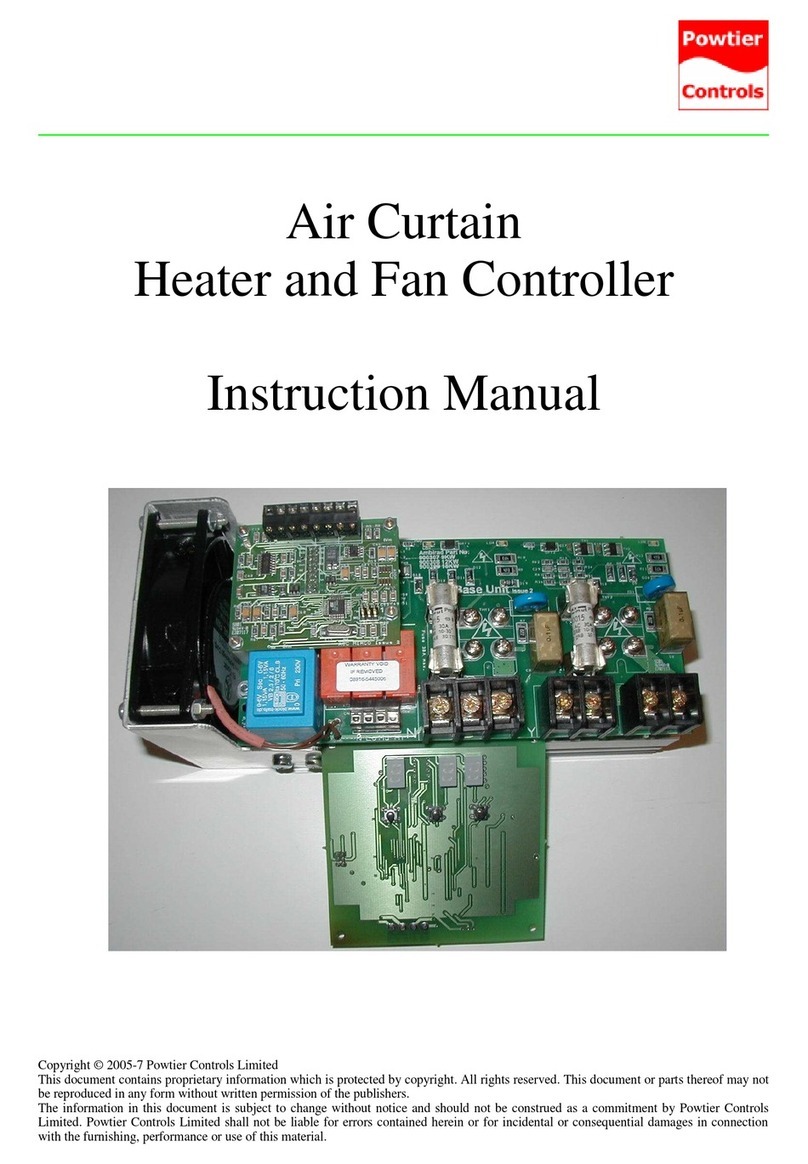
Powtier Controls
Powtier Controls ACC-6-00 instruction manual
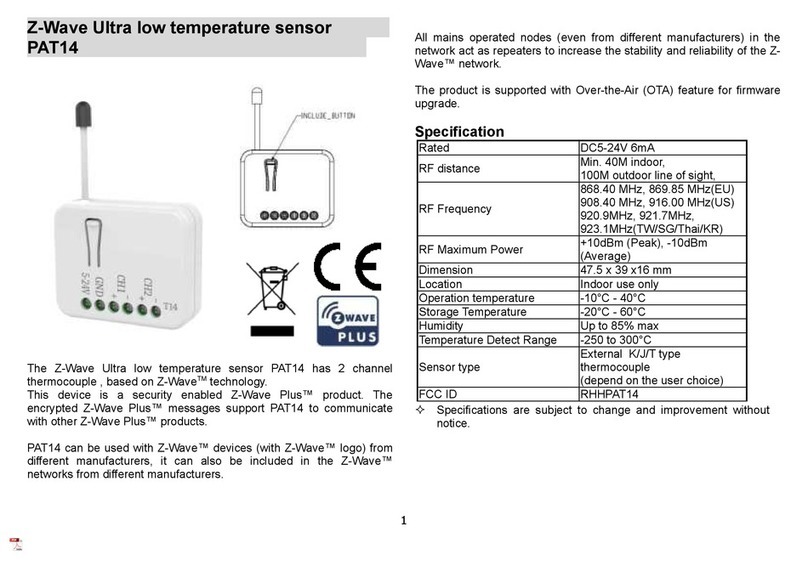
Philio
Philio PAT14 quick start guide
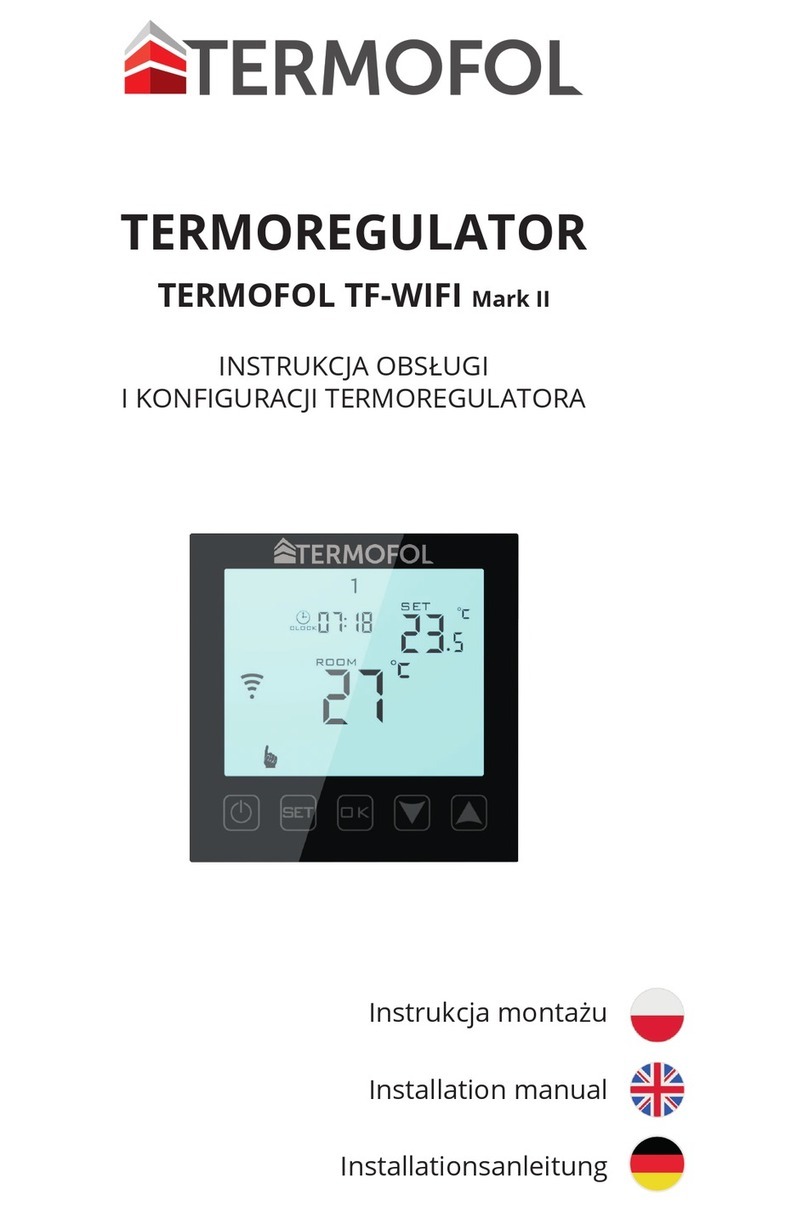
TERMOFOL
TERMOFOL TF-WIFI Mark II installation manual
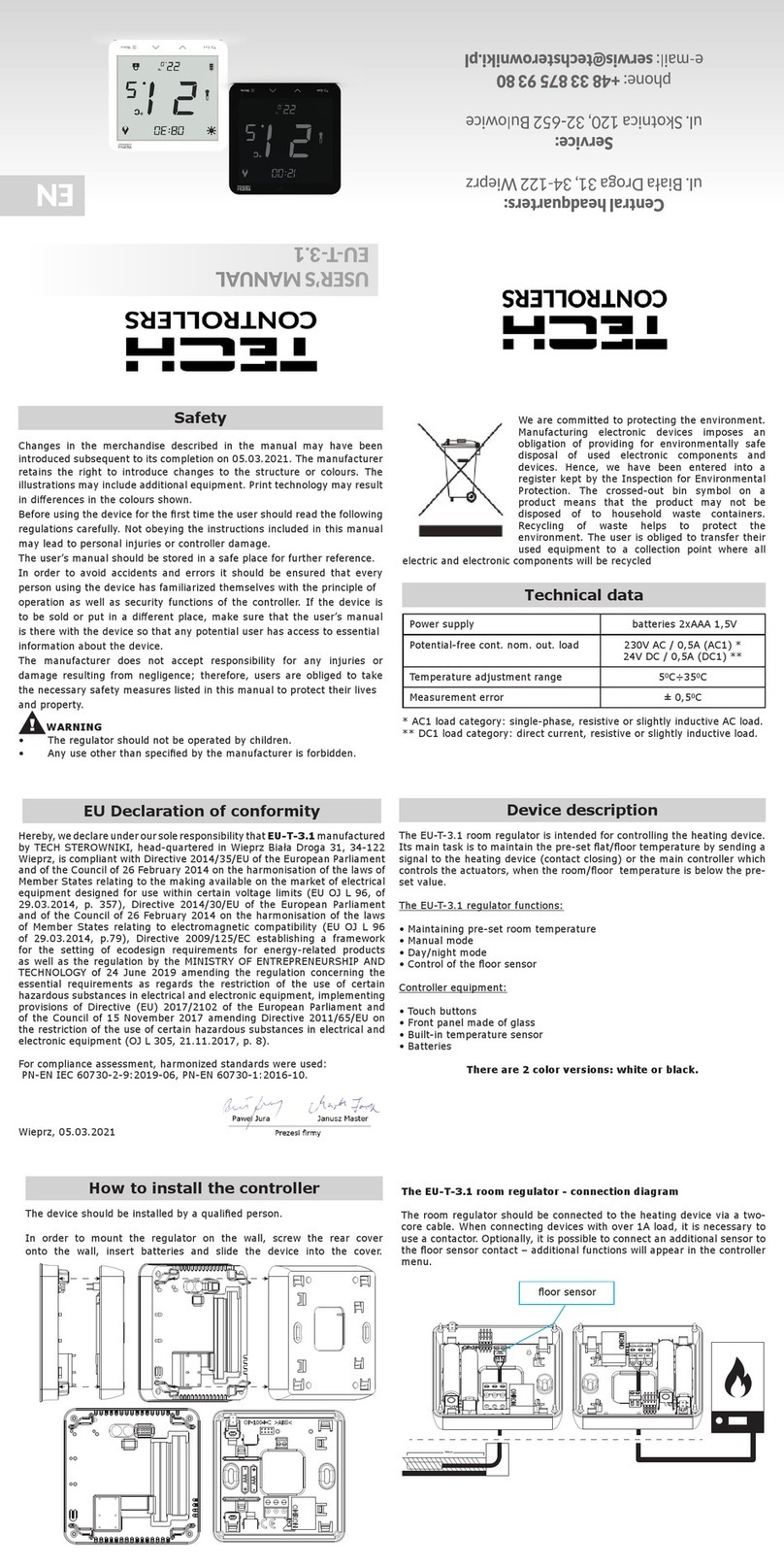
Tech Controllers
Tech Controllers EU-T-3.1 user manual
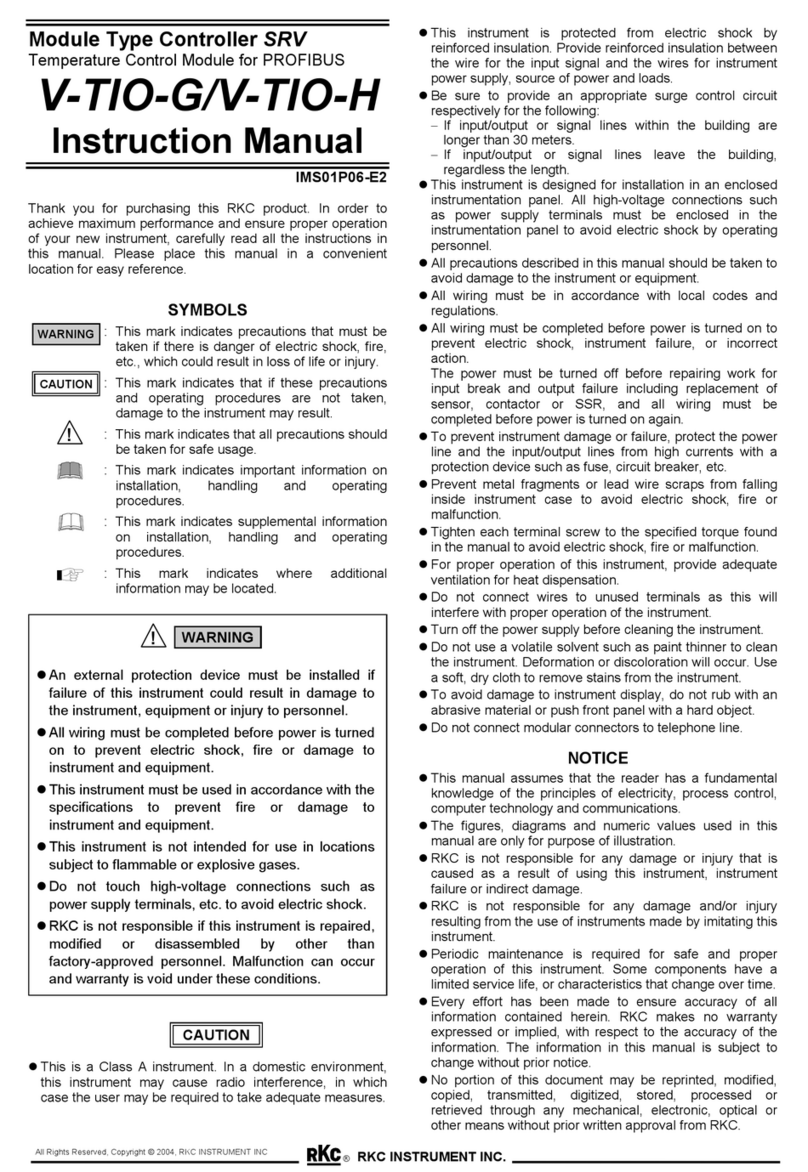
RKC INSTRUMENT
RKC INSTRUMENT V-TIO-G instruction manual
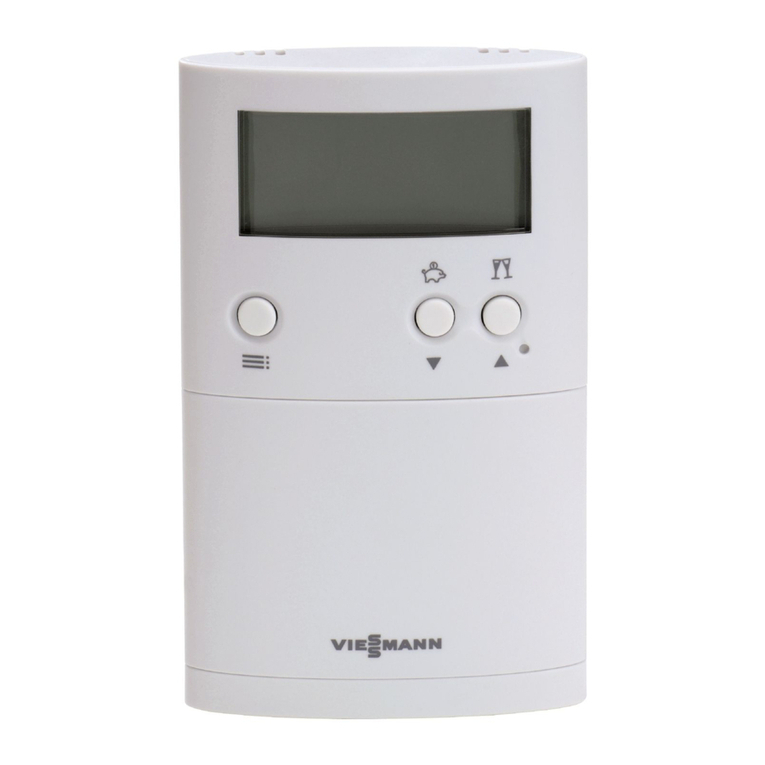
Viessmann
Viessmann VITOTROL 100 operating instructions

